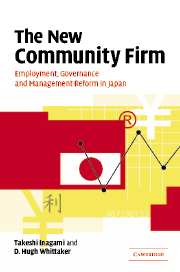Book contents
- Frontmatter
- Contents
- List of figures
- List of tables
- Preface
- Acknowledgements
- Part 1 The End of the Community Firm?
- Part 2 Hitachi: ‘Here, the Future’
- 8 Hitachi: A Dancing Giant
- 9 A Victim of its Own Success?
- 10 Organization Reform
- 11 Recasting the Employment Relationship
- 12 The Impact on Industrial Relations
- 13 Evaluation
- Part 3 The Reformed Model
- Appendix: Changes in Job Tenure
- References
- Index
11 - Recasting the Employment Relationship
Published online by Cambridge University Press: 22 September 2009
- Frontmatter
- Contents
- List of figures
- List of tables
- Preface
- Acknowledgements
- Part 1 The End of the Community Firm?
- Part 2 Hitachi: ‘Here, the Future’
- 8 Hitachi: A Dancing Giant
- 9 A Victim of its Own Success?
- 10 Organization Reform
- 11 Recasting the Employment Relationship
- 12 The Impact on Industrial Relations
- 13 Evaluation
- Part 3 The Reformed Model
- Appendix: Changes in Job Tenure
- References
- Index
Summary
In chapter 5 we saw that executives' views of corporate governance and employment reforms were only loosely coupled, at least in the late 1990s. So it was at Hitachi. Employment and human resource management (HRM) reforms actually began in April 1998, before the organization reforms outlined in the last chapter. It was only later that they became interlinked, and at the same time more ambitious.
Classic model employment practices had remained relatively un-changed at Hitachi for three decades because, personnel managers argued, they worked. By the mid-1990s, however, there were growing misgivings. The practices had been designed primarily around blue-collar workers, who in the 1960s constituted over half of the workforce. By the mid-1990s the proportion had declined to less than 30%. Most employees were now white-collar workers. The proportion of university graduates had risen from 10% to over 30%, and 1,750 had Ph. Ds. Increasingly, the future of the company depended on the creative output of such employees.
The practices were also designed around a youthful workforce, with an average age of 28 in the mid-1960s. By the mid-1990s this had risen to 39, and average tenure from seven years to eighteen years. This created pressures on labour costs, as well as on management tracks.
Stimulating white-collar creativity and performance, rethinking posts and promotion criteria, and controlling labour costs, therefore, were critical objects of reform. Then came moves to link management behaviour with the organization reforms described in chapter 10.
- Type
- Chapter
- Information
- The New Community FirmEmployment, Governance and Management Reform in Japan, pp. 178 - 197Publisher: Cambridge University PressPrint publication year: 2005



